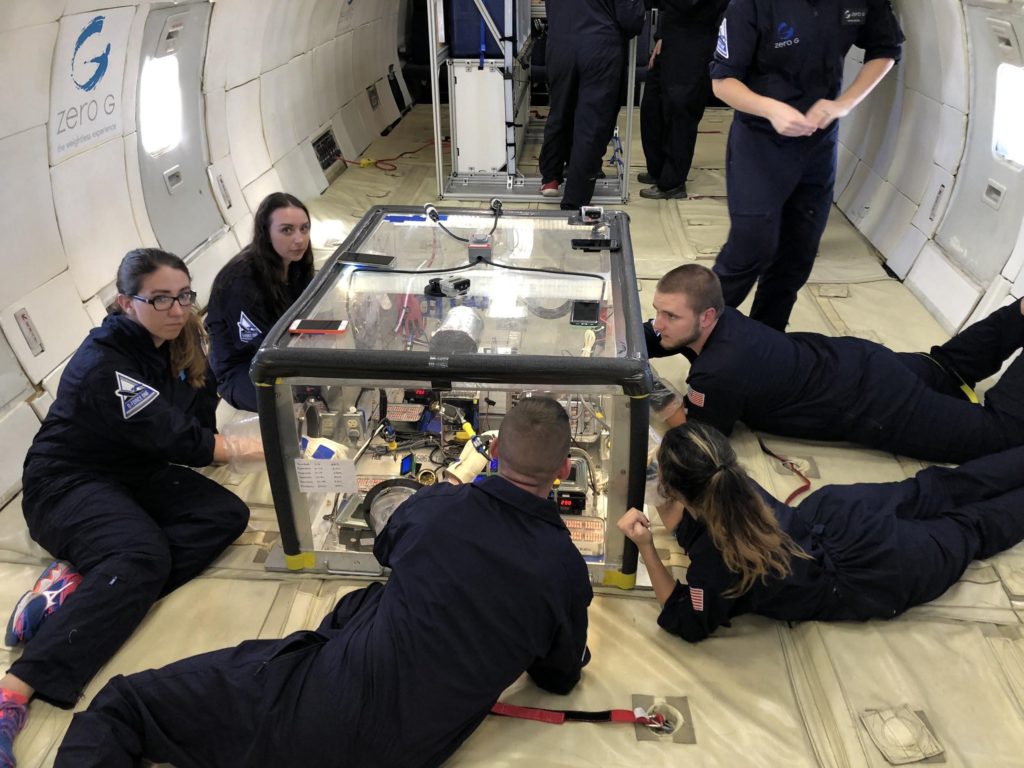By Sierra Portillo
With SpaceX’s recently successful launch, space travel is headed in new and exciting directions. NASA hopes private companies such as SpaceX and Boeing will provide opportunities for tourism, as well as chances to increase the number of experiments performed aboard space stations like the International Space Station.
Understanding the realities of microgravity is crucial to expanding human space travel. The unique environment affects both the physical and chemical properties of matter, ranging from everyday objects to human beings. Microgravity research began as early as the 1950s in the U.S., picking up traction in the 1970s. In recent years, college undergraduates have proposed experiments to aid scientists’ efforts, especially in the materials science field.
Materials science is a widely inclusive field relevant to various engineering disciplines. In the case of mechanical engineering, the field relates to mechatronics, or the engineering of mechanical and electrical systems, including robotics and electronics.
Repairs in Space
One of the major problems facing long-term space missions is the capability to repair electronics and circuitry. Electronic components are mended through soldering, which involves joining items together by melting a filler metal into their connecting joint. Unfortunately, solder joints produced in microgravity are found to have a higher porosity than those soldered on Earth. In other words, there is a greater measure of empty spaces, or voids, throughout the material, which make the joints weaker and easier to break.
Undergraduate students at West Virginia University (WVU) proposed adding iron particles to solder material to replace the missing buoyancy force and strengthen the joints. According to John Kulhman, research assistant professor at WVU and adviser to the project, the microgravity program officially began back in 2000. Kuhlman says the program was the first to offer hands-on experience to aerospace engineering students at WVU interested in space applications. Prior to its introduction, aeronautics was the curriculum’s primary focus.
Flying the Experiment
WVU’s research team worked in association with the Zero Gravity Corporation (ZERO-G), a privately held company founded to make space accessible to the public. The company provides university students the opportunity to test experiments in microgravity simulated on a special aircraft.
ZERO-G owns a remodeled Boeing 727-200 known as the G-FORCE ONE. Modifications were made to the aircraft to allow passengers to experience the feeling of weightlessness. To mimic a space environment, the plane ascends and descends in a uniform wave pattern referred to as parabolic flight. Much like an exaggerated roller coaster, passengers experience zero gravity at each peak and up to twice Earth’s gravity at the maneuver’s lowest points.
“It’s odd, because the maneuvers are way more gradual than any roller coaster ride, and you don’t do any loops or corkscrews,” Kuhlman explains. “But the ride lasts about 40 minutes. Plus, I got to fly on two flights, so just like the WVU students who fly, I was excited to be there to actually see how the experiment worked out.”
Five WVU students boarded the G-FORCE ONE in November 2018. They were the second group from the university to fly a variation of the soldering experiment, the first flying in November 2017. Careful measures were taken to guarantee the researchers’ safety. Teams were required to undergo a test readiness review beforehand to ensure experiments would not damage the plane or fellow passengers. For example, experiments had to be contained within sealed aluminum frame boxes.

After all flight work was finished, the team returned to West Virginia. Group members spent the rest of their semester reviewing and analyzing the results. Using WVU’s scanning electron microscope, the undergraduate researchers took pictures of solder joint samples from the flight. Batches of these images were run through a computer program responsible for calculating the porosity. Based on the data, the students could confirm or deny the experiment’s hypothesis.
Looking Forward
“Based on a Wilcox rank sum statistical model, there’s an 83% chance the hypothesis is valid,” says Aaron Dunkle, a graduate research student at WVU who assisted on the project and used the findings in his master’s thesis. “If we want to start sending astronauts further out in space or construct more efficient space stations, there need to be systems in place for equipment repairs that don’t require sending components back to Earth like we’re doing now.”
Not only does the program hold significance for future manned space missions, it also promises growth in West Virginia. Kuhlman says the research has positive influence on participants. He stressed an above average increase in a student’s skill set as well as independence and confidence.
About the Author

Sierra Portillo was born in West Virginia and graduated from West Virginia University in 2018 with bachelor’s degrees in mechanical and aerospace engineering. The latter half of her college career was spent working on the Microgravity Research Team. She currently resides in Hurricane, WV, as a production engineer for Toyota Motor North America and devotes any spare time to her tight-knit family and two cats.



